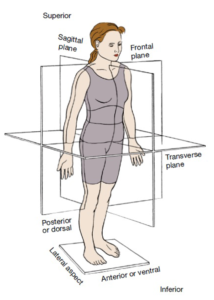
Knowing a muscle’s location, origin, insertion, and joint action helps a trainer understand how best to challenge it, strengthen it, and/or stretch it. An experienced trainer will be able to communicate where in the body participants should feel a particular movement. Identifying weakness, tightness, or other muscular imbalances allows trainers to provide valuable information to individuals that will help them move and feel better.

Joint Actions
- Flexion: Bending movement; decreases relative angle between segments
- Extension: Straightening movement; increases relative angle between segments
- Plantarflexion: Extension at the ankle; toes point away from knee
- Dorsiflexion: Flexion at the ankle; toes flex towards knee
- Abduction: Movement away from the midline of the body
- Adduction: Movement toward the midline of the body
- Internal rotation: Rotation toward the midline of the body
- External rotation: Rotation away from the midline of the body
Types of Muscle Actions
- Concentric: Muscle contracts and shortens; joint angle decreases
- Eccentric: Muscle elongates and lengthens; joint angle increases
- Isometric: Muscle contracts; force production occurs with no noticeable change in joint angle or muscle length
Anatomical Position and Planes of Motion

Source: www.acefitness.org
Anatomical position is the standard position used to describe the locations of body parts and their relationship to one another. A body in anatomical position stands upright with head and feet pointed forward, arms extended by the sides, and palms facing forward.
The human body is designed to move in multiple directions and in multiple planes of motion. When creating balanced exercise classes, all planes of motion – Sagittal, Frontal, and Transverse – are addressed. Participants should be challenged in different directions, at different angles, and in various positions for optimal results. By being mindful of these ideas, we ensure that participants are training the way the body is designed to move, which can improve performance and minimize pain in daily life and sport.
